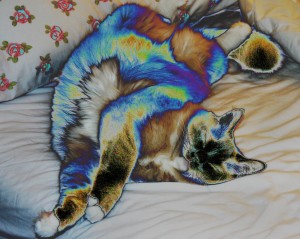I am not personally a great fan of extreme “Photoshopping.” For my generation the rock star we emulated was Ansel Adams. So the goal has been to achieve the ideal of his “range of light.” This translates to a few basic techniques:
- Spread the dynamic range from black to white – a process referred to as, in image processing parlance, as histogram equalization,
- Adjust the gamma to get the tonal range you want,
- Dodge and burn judiciously to accentuate the wanted and suppress the unwanted,
- And in some cases to tone subtlety.
But all this talk about “faking it” brought to mind a photograph that I took and played with in October of 2005. I called this, in honor, sorry honour, of an English friend “Radiant Tiddles.” This image is an example of a phenomenon known as “solarization.” The first thought that you often have about solarization is that it is a form of photographic magic. You will recall how the magic of photography is a theme of this blog. And let me tell you that in the “good old days,” when creating a solarization involved flashing a print with light half way through development, it certainly felt like witchcraft.
Arguably, the most famous solarization is Minor White‘s “The Black Sun, 1955.” This is a wonderful example, because you realize immediately what is going on. Somehow the extreme white of the sun stopped being white and turned black – somehow the tone reversed. You’ll hear this referred to as “reciprocity failure.” If we look up solarization in Wikipedia, we learn that it “is due to halogen ions released within the halide grain by exposure diffusing to the grain surface in amounts sufficient to destroy the latent image.” Let me say two things about that. First, the latent image was the ultimate magic inherent in film photography, the fact that light created a memory in the film that could wait for years* to be brought out by chemistry. Second, it’s a lot easier to understand as a digital phenomenon.
This understanding requires first an understanding of the concept of a “Look Up Table,” or “LUT.” The LUT is very central and key to understanding much of what we do to create an image in digital media; so well worth the effort of understanding.
*And I do mean years later. Film recovered in the Arctic in 1930 from an ill-fated balloon expedition in 1897 was successfully developed.

